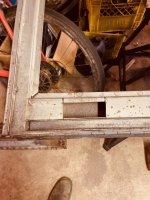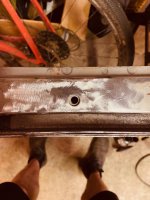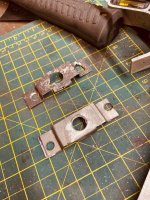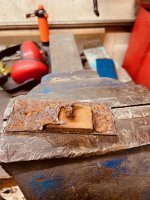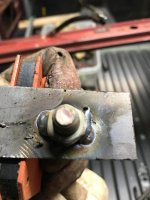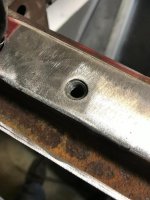I'm neck deep into a nut/bolt/panel resto of my 68 Bronco. My focus at the moment is trying to complete all the metal work with the (maybe unrealistic) goal of splashing paint on it this fall. When I started this project 4 years ago the only previous exposure to metal work and welding I had was in junior high metal shop 40 years ago. The learning curve has been steep but rewarding. I'm at the point now where my welding skills are beginning to catch up with my grinding skills. 
Anyway, today I turned my attention to the windshield frame, specifically the floating nuts inside the bottom tube of the frame, that are fastened through the dash with large bolts. One of these bolts was broken in the nut, while the other just spun without backing out. I checked the forum and found there are a few options to repair this fairly common problem. I decided to go the time consuming fabrication route because it gave me the opportunity to open up the frame and treat the inside with rust neutralizer. Keeping the floating nut as opposed to welding in a fixed nut also provides some flexibility when bolting everything together later, as the factory assembly tolerances on these old trucks were pretty wide and sometimes things don't seem to line up too well.
I cut open the frame around both mounting holes. The second picture shows the metal retainer that sits inside the frame and holds the floating nut that the dash bolt fastens to. As you can see one side was terrible corroded and the floating nut had fallen out of the retaining plate. On the other side the retained plate was in better shape but was corroded to the point that it wasn't actually retaining the nut.
I made two new sets of face plates, retaining plates and floating nuts. After welding the retaining plates to the face plates I diy zinc plated all the new parts (super easy and interesting) to prevent corrosion. I then rust protected the inside of the frame.
I lightly ground off the zinc from the welding edges, inserted the assembly into the frame and stitched in the new face plates to the frame. A little bit of grinding, and its ready for a very light skim of filler.
I'm quite happy with the way it turned out. This may not be the quickest solution to the problem but its one viable option, especially if you don't have to worry about paint. Hopefully my experience can help others who may be interested in this approach.
Anyway, today I turned my attention to the windshield frame, specifically the floating nuts inside the bottom tube of the frame, that are fastened through the dash with large bolts. One of these bolts was broken in the nut, while the other just spun without backing out. I checked the forum and found there are a few options to repair this fairly common problem. I decided to go the time consuming fabrication route because it gave me the opportunity to open up the frame and treat the inside with rust neutralizer. Keeping the floating nut as opposed to welding in a fixed nut also provides some flexibility when bolting everything together later, as the factory assembly tolerances on these old trucks were pretty wide and sometimes things don't seem to line up too well.
I cut open the frame around both mounting holes. The second picture shows the metal retainer that sits inside the frame and holds the floating nut that the dash bolt fastens to. As you can see one side was terrible corroded and the floating nut had fallen out of the retaining plate. On the other side the retained plate was in better shape but was corroded to the point that it wasn't actually retaining the nut.
I made two new sets of face plates, retaining plates and floating nuts. After welding the retaining plates to the face plates I diy zinc plated all the new parts (super easy and interesting) to prevent corrosion. I then rust protected the inside of the frame.
I lightly ground off the zinc from the welding edges, inserted the assembly into the frame and stitched in the new face plates to the frame. A little bit of grinding, and its ready for a very light skim of filler.
I'm quite happy with the way it turned out. This may not be the quickest solution to the problem but its one viable option, especially if you don't have to worry about paint. Hopefully my experience can help others who may be interested in this approach.











